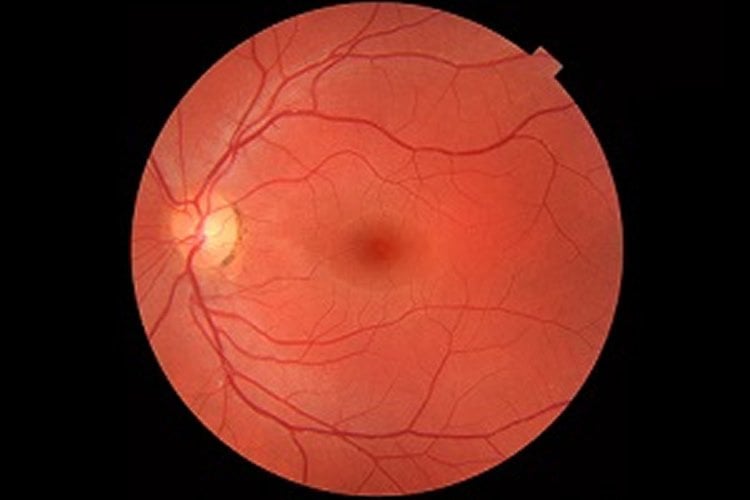Scientists at The University of Manchester have successfully restored the sight of laboratory mice suffering from a common cause of blindness in people.
A team led by Rob Lucas, GSK Professor of Neuroscience, carried out the pioneering research which may help sufferers of retinitis pigmentosa, a group of inherited eye disorders.
The treatment works by expressing a light sensitive human protein called rod opsin into the undamaged cells of the retina, so that it will turn them into special cells called photoreceptors which enable sight.
It was trialled on mice who had inherited advanced retinal degeneration and so were essentially blind.
The mice were able to distinguish flickering from steady light as well as spatial patterns and a ‘natural movie’ – an advance on attempts to combat the disorders using non-human proteins.
Retinitis pigmentosa is a leading cause of blindness worldwide: 1.5 million people worldwide are thought to be currently affected.
Using a human protein, says Professor Lucas, is as advantageous as it is less harmful and easy to produce.
Professor Lucas said: “We aim to find ways of restoring photosensitivity to the retina in conditions such as retinitis pigmentosa in which loss of rod and cone photoreceptors lead to blindness.

“The protein rod opsin seems to be relatively successful under normal office light conditions, with images presented using standard computer screens.
“Other researchers have also had some success using other sorts of light protein, but these generally require much brighter light beyond what we generally experience.”
Source: Mike Addelman – University of Manchester
Image Source: The image is adapted from the University of Manchester article
Original Research: Full open access research for “Restoration of Vision with Ectopic Expression of Human Rod Opsin” by Jasmina Cehajic-Kapetanovic, Cyril Eleftheriou, Annette E. Allen, Nina Milosavljevic, Abigail Pienaar, Robert Bedford, Katherine E. Davis, Paul N. Bishop, and Robert J. Lucas in Current Biology. Published online July 30 2015 doi:10.1016/j.cub.2015.07.029
Abstract
Inactivation of Protein Tyrosine Phosphatase Receptor Type Z by Pleiotrophin Promotes Remyelination through Activation of Differentiation of Oligodendrocyte Precursor Cells
Highlights
•Ectopic human rod opsin restores visual functions in advanced retinal degeneration
•Rod opsin has greater sensitivity than current optogenetic strategies
•Rod opsin-treated animals respond to spatial stimuli, flicker, and natural scenes
•As a human protein ordinarily found in retinal tissue, barriers to clinic are minimized
Summary
Many retinal dystrophies result in photoreceptor loss, but the inner retinal neurons can survive, making them potentially amenable to emerging optogenetic therapies. Here, we show that ectopically expressed human rod opsin, driven by either a non-selective or ON-bipolar cell-specific promoter, can function outside native photoreceptors and restore visual function in a mouse model of advanced retinal degeneration. Electrophysiological recordings from retinal explants and the visual thalamus revealed changes in firing (increases and decreases) induced by simple light pulses, luminance increases, and naturalistic movies in treated mice. These responses could be elicited at light intensities within the physiological range and substantially below those required by other optogenetic strategies. Mice with rod opsin expression driven by the ON-bipolar specific promoter displayed behavioral responses to increases in luminance, flicker, coarse spatial patterns, and elements of a natural movie at levels of contrast and illuminance (≈50–100 lux) typical of natural indoor environments. These data reveal that virally mediated ectopic expression of human rod opsin can restore vision under natural viewing conditions and at moderate light intensities. Given the inherent advantages in employing a human protein, the simplicity of this intervention, and the quality of vision restored, we suggest that rod opsin merits consideration as an optogenetic actuator for treating patients with advanced retinal degeneration.
“Restoration of Vision with Ectopic Expression of Human Rod Opsin” by Jasmina Cehajic-Kapetanovic, Cyril Eleftheriou, Annette E. Allen, Nina Milosavljevic, Abigail Pienaar, Robert Bedford, Katherine E. Davis, Paul N. Bishop, and Robert J. Lucas in Current Biology. Published online July 30 2015 doi:10.1016/j.cub.2015.07.029







